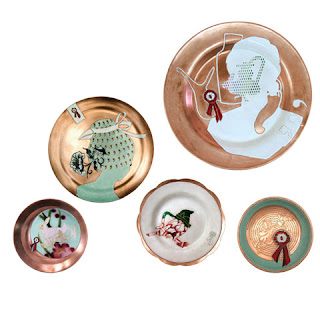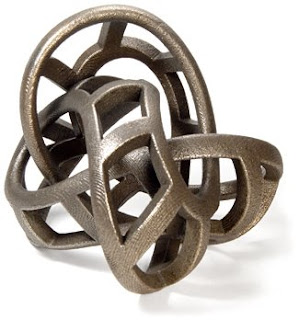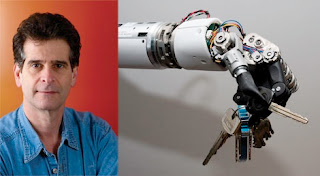
So I noticed today in Barnes and Noble that Lark's 500 Pendants and Lockets is out now. Check out page 212 to see yours truly!
Piecing it Together








"Despite the mock funeral service held in 1980 for the term Scandinavian design by a group of Oslo designers, Scandinavian design ideals that emerged in the 1950s have survived in the Nordic countries. This must be seen, in part, as the result of an international interest in this period's design on a world basis. A number of international designers have found a source of inspiration in this "golden age" as well as in our contemporary Nordic design where the demand for minimalism, stylisation and a new interpretation has been dominant. Indeed, many Scandinavian designers have felt this earlier tradition to be a burden, but to an even greater number it has brought inspiration and self-assurance. In the course of half a century, Scandinavian design has become an established phenomenon, retaining its positive resonance. During the flowering of postmodernism in the 1970s and 1980s, there was less focus on the concept, but by the early 1990s however, it had made a comeback. Now the time has come for a serious reassessment of Scandinavian design, including all the countries in the Nordic community that have contributed to the formation of this identity: Denmark, Iceland, Finland, Norway and Sweden.
Traditionally, Scandinavian design has been associated with simple, uncomplicated designs, functionality and a democratic approach. These are the characteristics that must be reassessed in the light of recent research on modernism. In any case, Scandinavian design provides us with a paradigm in order to understand the making of the modern world, and we see that it still has meaning for people the world over. The concept has been a substantial theme for scholarly debates, enlightening exhibitions and marketing agendas for the last fifty years.
Lightness, Quickness, Exactitude, Visibility, Multiplicity and Consistency. Such vital qualities are concepts that are easily associated with many aspects of Scandinavian design,
I took that directly from the scandesign website, because frankly, I can't explain it any better. Of course when we think of Scandinavian design, Ikea comes to mind. I feel that Ikea is Scandinavian design at it's most distilled. Selvedge devoted an entire issue to Scandinavian textiles a few months ago and the work/products they focused on seem so much richer and (and better made) than anything from Ikea. Perhaps it's the handcrafted edge. Perhaps that sleek, modernism appears to have a softer side, becuse Selvedge focuses on textiles.





"Chee Pearlman is the director of Chee Company, an editorial and curatorial design consultancy. Projects include serving as program director of the Art Center Design Conference in Los Angeles and working with and writing for a number of publications, including Newsweek, Travel + Leisure, Popular Science and The New York Times. She is the curator of the exhibition "The Voting Booth Project" at Parsons School of Design featuring 50 leading architects and designers who poignantly re-imagined actual voting booths used in the 2000 election in Florida. Chee founded and chaired of the Chrysler Design Awards for its ten-year duration and is the former Editor-in-Chief of I.D. Magazine, which received five National Magazine Awards under her tenure." (I pulled this from the net, I can't really say it any better.)
Radical Craft:Idea of the making, connection of the brain and the hand. (Listen to interview with Chee about Radical Craft) but not in terms of macrame (poor macrame, it always gets picked on,) but in terms of objects like the Mars rover.
Chee Pearlman is a curator, looking at the cutting edge of design. She feels that design is in the "central sweet spot" in terms of cross discipline. Many fields have a design component. She also spent two years programming the Radical Craft Conference in Pasadina CA, in 2007.
In Wired, Chee Pearlman moderated a panal on design with: Paola Antonelli, Tim Parsey, Bruce Sterling, Lee Green, Lorraine Wild, Don Norman, Ayse Birsel, Tucker Viemeister, David Kelley, Ted Selker, Ray Riley, Ettore Sottsass, Erik Adegard, Robert Brunner,Trevor Creed, Gary Fisher, Andy Proehl, Rick Valicenti, Richard Saul Wurman and Susan Yelavitch.



"Founded in 1982 by Dean Kamen, DEKA consisted of a relatively small group of individuals and lots of innovative ideas. Today, almost 200 engineers, technicians, and machinists work in our electronics and software engineering labs, machine shop, and on CAD stations. Our facilities have been designed to promote constant interaction between and within the engineering groups. Our on-site machine shop and molding facility are central to the success of our projects; ideas are prototyped and tested in record time.
DEKA is a company where the questioning of conventional thinking is encouraged and practiced by everyone - engineers and non-engineers alike -because open minds are more likely to arrive at workable solutions. This has been our formula for success since we began, and it will continue to drive our success in the future."
Why he is important: Dean Kamen is important because he is making products that make a difference in people's live and in the world. His goal isn't to make stuff or money, but to make the world a better place. He's also reaching out to younger generations in order to get them excited about science and technology. He is designing products to slove social issues.
